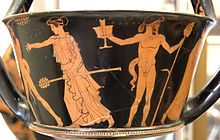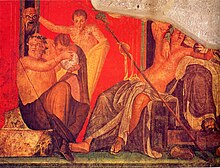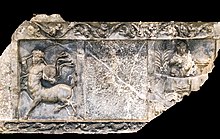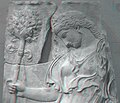Thyrsos





The Thyrsos ( Greek θύρσος , plural: Thyrsoi, Latin Thyrsus ), rarer Thyrsos staff or Bacchus staff is a staff in Greek mythology that is worn as an attribute of Dionysus and his companions, the maenads and the satyrs .
Origin and forms of the thyrsos
The thyrsos was a staff that is said to have consisted of a stalk of giant fennel , in any case the term narthex (fennel stem ) is used by Euripides as a synonym for thyrsos. Insofar as they are synonyms, Thyrsos seems to be the older name; at least that's what a Euripides Scholion says .
The thyrsos is usually shown wrapped in bandages or with vine leaves . At the top there was a crown made of ivy or vine leaves, and in later times often a pine cone . The representations of the crown are very different. Sometimes it consists of a twig with a few leaves, sometimes it is a fennel umbel, at other times an elaborate, bushy container with ivy leaves arranged in regular rows, sometimes the leaves are naturalistic, sometimes only indicated by dots.
Likewise, the shaft can sometimes be clearly identified as a fennel stem in the depictions, sometimes apparently a wooden stick, sometimes a raw stick, at other times a carefully smoothed stick wrapped with ribbons. Ultimately, the vegetable attributes of the Dionysus cult (ivy, wine and fennel) are combined with each other in almost any way, in all degrees between completely raw and completely artificial. Only the fir and the fir branch appear only in isolated, early specimens and later disappear entirely from Dionysian iconography . And finally, the length of the thyrsos varies considerably between a man's height and an inch.
Despite all the variability in the representation, the Thyrsos was more or less straight in all ancient illustrations, only in modern times have there been depictions of Thyrsoi that resemble a shepherd's crook (e.g. in a fresco by Giovanni Francesco Romanelli ).

Finally they came from in the 19th century representations Dionysian staff as part of a bucolic genre painting and tried in the wake of Nietzsche (sometimes only limited success) to a more authentic representation of the "Dionysian" how to fully clothed about when, in a tiger skin draped Dionysus priestess by John Collier sees in her right hand a very sturdy thyrsos crowned by a pine cone, which, without any wine, ivy or ribbons, looks more like a spear than a prop for a wine festival (see Thyrsolonchos ).
Whether in the "original form" of the thyrsus itself can be identified with the narthex, or whether it was originally a staff that was replaced by the lighter fennel stem on the orders of Dionysus, so that those intoxicated with wine would not injure themselves with their staffs, remains not clear.
etymology
The origin of the word is also unclear. Thyrsos is documented for the first time (and often there) in Die Bakchen , a tragedy by Euripides . Otherwise the evidence in classical Greek literature is very sparse; with the beginning of Hellenism the word appears frequently.
The stem θυρσ- appears in different plant names, for example in θυρσίνη ( summer root ), θύρσιον ( thyme ) and θυρσίτης ( glue plant ) without these plants being related or similar, from which Papen concludes that the stem must be related to a name for a part of a plant . He suspects that, since the narthex is the shaft, thyrsos as part of the plant must correspond to the crown. This agrees that in Hesychios the Thyrsos is referred to as Klados (branch, sapling).
Bearer of Thyrsus

In ancient art, the thyrsus appears as an attribute from 530 BC. Very common with the maenads, occasionally also with satyrs and silenus , the god Dionysus himself or his wife Ariadne . Ultimately, he is the defining attribute of God and his followers, i.e. H. the moment a figure from mythology appears in the Thiasos , the Thyrsos is also added to it. Therefore:
- one sees Hephaestus , who is brought back to Olympus by Dionysus , drunk waving the Thyrsus.
- Likewise, the Centaurs and Pan , which originally did not belong to the entourage of the god, are shown from the Hellenistic period with thyrsos and other Dionysian attributes; conversely, Pan gives off his peculiar flute , which is typically an instrument played by satyrs.
- Eros , who has also been Dionysus' companion since the 4th century, occasionally wears a thyrsus.
In some cases it remains unclear why a deity wears the thyrsus, e.g. B. in depictions of Nike or Roma with Thyrsos.
The thyrsus was also worn by the initiates of the Dionysus mysteries or is their attribute, therefore Plato says in the Phaedo :
- Thyrsus carriers are many, but real enthusiasts are few
in the sense of Because many are called, but only a few are chosen . To what extent the Thyrsos is to be understood as an attribute of the initiated and the followers of Dionysus metaphorically or in a very practical and real way remains uncertain. When Plutarch said an unknown tragedian
- Gone are the youth and the Thyrsos is resting
quoted, or at Juvenal 's
- Singing and thyrsos are forbidden to poverty ,
so it remains unclear whether the Thyrsos figuratively here, or whether it is a concrete object, such as a fool robe that the carnival is in the closet, because the former carrier older and more mature (or poorer) has become.
The Thyrsus was even able to penetrate the political symbolism of the Roman Empire: When Mark Antony at the beginning of 41 BC When he moved into Ephesus BC , he was venerated as the New Dionysus : women dressed as Bacchantes and men dressed as panes and satyrs carried thyrsos sticks in the solemn procession before the triumvir. On the obverse of a silver tetradrachm from Ephesus, the portraits of Mark Antony and Octavia , the sister of Octavian and since autumn 40 BC, appear. Wife of Mark Antony, the reverse shows Dionysus with Thyrsos and Kantharos, standing on the Cista mystica and framed by two snakes.
Thyrsolonchos
The thyrsos is also used as a weapon by the maenads, or they use lances disguised as thyrsoi, for example on Dionysus' journey to India or they are used in the killing of Pentheus . This combination of thyrsos and lance is first used by Kallixeinos of Rhodes in the description the festival procession of Ptolemy II (winter 275/74 BC) mentioned, where the actors of the god and the maenads carried such thyrsos lances ( θυρσόλογχος thyrsolonchos ). The distinction between Thyrsos and Thyrsoslance seems to have been blurred later. Macrobius asks e.g. B. what the difference is, and in the Dionysiacs Nonnos only speaks of thyrsoi , even where they are obviously used as a weapon.
Thyrsus outside the cult of Dionysus
It is difficult to say what exactly was or is to be understood by a thyrsos , since the term was apparently also used more generally for parts of plants that were tied together, wrapped rods and the like. Ä., Which were used in a festive and cultic context. Plutarch z. When describing a Jewish feast of tabernacles , B. names the lulav , a bundle made from the branch of a date palm , the etrog and branches of myrtle and willow , also thyrsos , and also in the 2nd Book of the Maccabees and in Josephus Lulav is translated as thyrsos .
Or even more generally in Latin, where thyrsus , tirsus or tursus were simply used to denote the stem or stem of a plant, e.g. B. Pliny as a name for the stem of the asparagus . Today, therefore, the Latin thyrsus in botany denotes a special inflorescence , see under Thyrsus .
literature
- Mark W. Edwards: Representation of Maenads on Archaic Red-Figure Vases. In: The Journal of Hellenic Studies . Volume 80, 1960, pp. 78-87
- Walter Hatto Groß : Thyrsos 1). In: The Little Pauly (KlP). Volume 5, Stuttgart 1975, Col. 809.
- Ferdinand-Gaudenz von Papen: The Thyrsos in Greek and Roman literature and art. Dissertation Bonn 1905 digitized
- A. Reinach: L'Origine du Thyrse. In: Revue de l'Histoire des Religions . Volume 66, 1912, pp. 1-48.
Web links
Individual evidence
- ↑ Euripides Bakchen 205, 704
- ↑ Scholion on Euripides Orestes 22, s. Papen note 22 p. 47
- ↑ Diodorus 4.4; Plutarch quaestiones convivales 714e
- ↑ Papen Thyrsos 9f
- ↑ Papen Thyrsos p. 12, note 28
- ↑ Edwards Representation of Maenads S. 84ff
- ↑ Papen Thyrsos p. 38f
- ^ Plato Phaedo 69, transl. By Schleiermacher
- ↑ Mt 22:14 EU
- ↑ August Nauck Tragicorum Graecorum Fragmenta 2nd ed. 1889, Fragment 397
- ↑ Juvenal Satires 7.60
- ^ Plutarch, Antonius 24.4
- ↑ Diodorus 3.65.3
- ^ Curtius wall painting Pompeii. Leipzig 1929, reprint: Hildesheim 1960. p. 153 fig. 99
- ↑ In: Athenaios Deipnosophistai 200d, f
- ↑ Macrobius Saturnalia 1.19
- ↑ 2 Makk 10.7 EU
- ↑ Josephus Jewish Antiquities 13.13.5
- ↑ Pliny naturalis historia August 19, 1942







